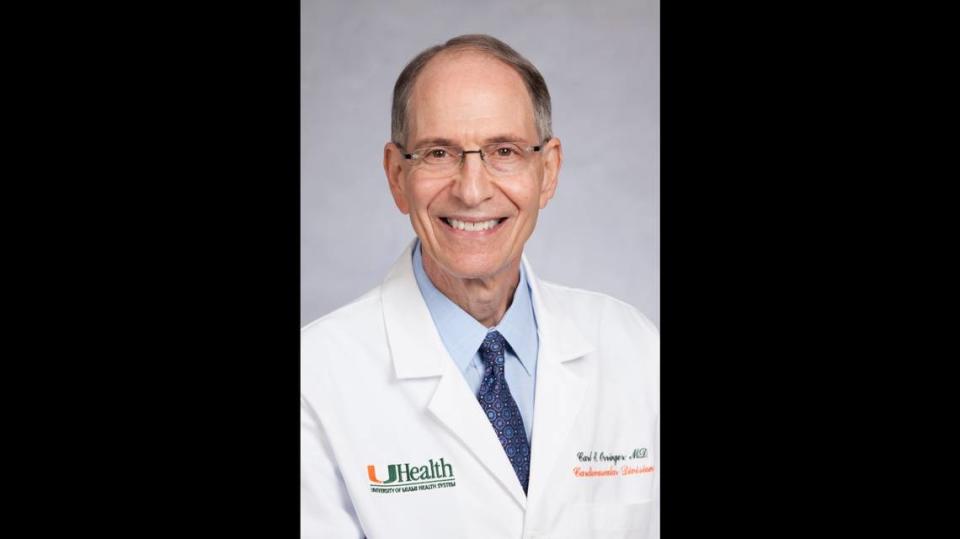Overweight young people are already showing signs of heart disease, clogged arteries
Premature heart disease — mostly, heart attacks — is unfortunately becoming more common.
While the average age for a first heart attack in men is 64 and 70 for women — as many as 4 to 10 percent of all heart attacks occur before age 45. Most of these strike men.
Cardiovascular issues are considered a “senior citizen” disease “because by the time people reach their 60s, the disease has already had lots of time to progress,” explains Dr. Tarak Rambhatla, a cardiologist at Baptist Health’s Miami Cardiac & Vascular Institute. But over the years he and other cardiologists have observed a troubling uptick in younger patients.

“I’m definitely seeing this in my practice,” he adds. “Between 15 to 20 percent of the younger patients I’m seeing now show some level of plaque development.”
Young people getting heart attacks is rising
This rise in heart disease among young people comes at a time when the U.S. is actually recording fewer heart attacks because of the use of statins (cholesterol-lowering drugs) and a decline in smoking.
Yet, the proportion of young people having a heart attack has been rising by 2 percent each year for the past 10 years, according to research presented at the American College of Cardiology’s annual scientific conference in 2019.
Though a heart attack can occur quickly, the buildup of plaque develops over years. This sticky substance made up of cholesterol, calcium, fat and other substances eventually narrows and hardens arteries, limiting the flow of blood. This is known as atherosclerosis.
Atherosclerotic blockage in coronary arteries is the prime culprit of heart attacks in people 45 and under, as it is with older patients. The difference between older and younger patients, however, is that older people tend to have two or three diseased arteries, while younger patients usually have one.
Doctors also report that younger patients — more so than their older counterparts — are substance abusers, namely of marijuana and cocaine.
Of course, not all heart attacks in young adults can be blamed on blockages. Other medical conditions do come into play, but they’re in the minority. Four percent of younger patients’ heart attacks are due to inborn abnormalities, 5 percent to blood clots and another 5 percent to various disorders. About 6 percent are triggered by a range of causes, from radiation therapy for chest tumors to chest trauma.
Poor diets, no exercise, smoking are biggest culprits
Lifestyle choices, however, shoulder most of the blame. “We’re finding the same risk factors regardless of age,” says Dr. Carl Orringer, a cardiologist with the University of Miami Health System. “Diabetes, smoking, high blood pressure, high cholesterol, sedentary lifestyle.”

What’s more, these factors don’t just lead to heart attack. They can also trigger strokes in the 45-and-under set. “Many people think that because they’re young it can’t happen to them,” Orringer adds. “But it does. It’s happening. It’s not impossible.”
Dr. Yadira Martinez, director of outpatient cardiology at Nicklaus Children’s Hospital, has noticed more hypertensive children in her practice as well as children with high cholesterol and elevated blood sugar levels. “Just yesterday I saw 3 or 4 kids with hypertension,” she says. “And that’s not uncommon.”

Most of her patients are overweight or obese. They rarely exercise. Weight management is a problem because their parents also tend to be obese, she says, noting that up to 80 percent of children who are overweight or obese will grow up to face the same issue as adults.
“The risk factors you see in childhood result in the damage you see in adults,” she says. “It doesn’t just happen overnight.”
Seeing artery damage in overweight teens, young adults
A study in the Journal of the American College of Cardiology confirms this. When damage to arteries begins in the teens and the 20s — due to high LDL levels (what people refer to as “bad cholesterol”) — the result is cumulative. It might also be irreversible, increasing the chances of developing heart disease in mid-life.
Cardiologists agree that people of all ages should heed the advice of eating healthy, not smoking, exercising regularly, and sleeping seven to eight hours a night. Laying off the alcohol (or other drugs) is also essential.
In addition, “it’s also important to have periodic health evaluations,” Orringer said. “If you’re not seeing your doctor regularly, you’re missing the opportunity to catch the problem.”
Carlos Blandino 53, of Kendall, knows this all too well. Four years ago, he was diagnosed with hypertension after heart palpitations scared him into going to a cardiologist. Though his father had had a triple bypass surgery in his early 50s, he had been putting off such a visit for a while. Except for the occasional high BP reading and family history, Blandino had no other risk factor.

After tests and diagnosis, he was put on medication that help his blood vessels dilate. He now takes his blood pressure every day. His son, 21, was recently diagnosed as hypertensive as well. “My advice is don’t wait,” says Blandino, who is a registered nurse. “When you’re young you think, oh, this can’t happen to me. But it does. It happened to me. It happened to my son.”
During a visit, a doctor will collect your family medical history as well as track the numbers that go a long way to predicting a potential heart attack.
Know your key health markers
“Know your numbers,” says Rambhatla of Baptist Health. “Your cholesterol, your BMI (body-mass index), your sugar level, your blood pressure. This is important even if you’re young.”
Cardiologists also suggest learning your coronary artery calcium score, which measures the amount of calcium in the arteries supplying your heart muscle. To get this number, a special non-contrast CT scan of the heart can show hardening of the artery wall. Depending on the score — the base reference is zero — doctors can estimate the risk of a heart attack (or stroke) in the next 5-10 years.
The calcium score is used only with patients who haven’t already been diagnosed with heart disease. While a high calcium score doesn’t mean a heart attack is around the corner — just as a zero score doesn’t confer absolute protection — “it is a great tool in determining how aggressive we have to be,” says Rambhatla.
While we can’t control the genetic cards we’ve been dealt, lifestyle factors are certainly modifiable. The famous Framingham Heart Study found that if a man is free of six major risk factors — high total cholesterol, low HDL (“good”) cholesterol, high blood pressure, diabetes, obesity and smoking — he has only a 5 percent risk of developing cardiovascular disease by age 95. But add two or more risk factors and that shoots up to 69 percent.
“It proves how important early prevention by managing risk factors and lifestyle changes can be,” says Orringer.

